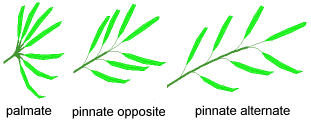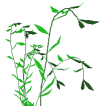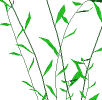Leaf parameters
The parameters in the Leaves section describe how leaves are created, grow, and are drawn.
Leaf 3D object, scale, rotations, colors
See the section on A common suite of parameters for drawing 3D objectsA_common_suite_of_parameters_for_drawing_3D_objects.
Petiole length/width when leaf has optimal biomass
Petiole growth depends on leaf growth, so the petiole will only reach its full length and width when the leaf 3D object reaches its full size. For sessile (attached) leaves, you should set the petiole length to zero. For compound leaves, the petiole length affects both the stalk of the entire leaf and the stalks of individual leaflets.
Angle between stem and petiole
This is the angle between each leaf and the stem it comes from. For most plants angles between 20 and 80 degrees are reasonable.
Number of leaflets
Compound leaves are leaves that are not whole (entire) but are made up of a series of smaller leaflets. Non-compound leaves are also called simple leaves. To specify compound leaves, change the number of leaflets to a number greater than one.
Compound leaf shape; if pinnate, alternate or opposite
You can choose between pinnate (feather-shaped) and palmate (hand-shaped) leaves. For pinnate leaves, you can choose to have the leaftlets face each other (opposite) or sit on the stem left-right-left-right (alternate).

If compound, spread index
This index is a percentage of the petiole length to draw each portion of stem between leaflets. For pinnate leaves, it is both the length of the portion between where leaves come off the main leaf stalk (called a rachis) and the length of each leaflet stalk. For palmate leaves it is the length of each leaflet stalk only.
If compound, bend angle at start, If compound, bend angle at full size
These two parameters can cause pinnate compound leaves to “unfold” as they grow. They have no effect on palmate compound leaves. The start angle is the angle between successive leaflets when the leaf first appears on the plant, and the angle “at full size” is the same angle when the leaf is fully grown.
|
|
|
|
more bending at start |
less bending later |
One important thing to remember in setting these parameters is that many leaves never reach “fully grown” size because of time or biomass limits. So you may need to set either of these numbers higher or lower than you might think to get the effect you want. Don’t worry about that; just play with the numbers and animate the plant.
Petiole taper index
This parameter causes leaf (or leaflet) stems to taper as they approach the leaf 3D object, so that the intersection of stem and 3D object looks more natural. For no tapering, set this index to 100%; for tapering, lower the index. Tapering works only on the screen and in 3D outputs other than POV; it doesn’t work for POV output. Tapering looks best when there are more line segments per line (change the parameter General parameters: Number of segments to draw to create curved line). If your leaf petioles are already thin, you won’t be able to see much tapering. For compound leaves, this parameter applies to petiolets (leaflet stems), not leaf stalks.
Growth curve
Like the whole plant and the fruit, leaves have an S-shaped growth curve. Changing the shape of this curve will affect the distribution of biomass over the plant, since it determines how much biomass each leaf asks for as it grows. For example, a flat curve will produce a plant with mostly leaves of the same size, whereas a curve that moves up sharply will produce a plant with large and small leaves.
Optimal biomass, Minimum/maximum days for meristem to create, Minimum fraction of optimal biomass needed to create, Minimum/maximum days to grow
See the section on A common suite of parameters for growthA_common_suite_of_parameters_for_growth>second.
Stipule 3D object, scale, rotations, colors
All the typical leaf-like 3D object parameters are available for stipules2UUQ_X_.
Number of sections to make up stipule
Unlike leaves, stipules can create a 3D look (for things like thorns) by spinning one 3D object around in a circle as buds and fruits do.
Angle between stipule and main stem
This is the angle at which the stipule comes off from the plant stem, not from the leaf stalk. Normally you will want to make sure that this angle is less than the angle between the leaf and the stem.
Created with the Personal Edition of HelpNDoc: Free iPhone documentation generator

